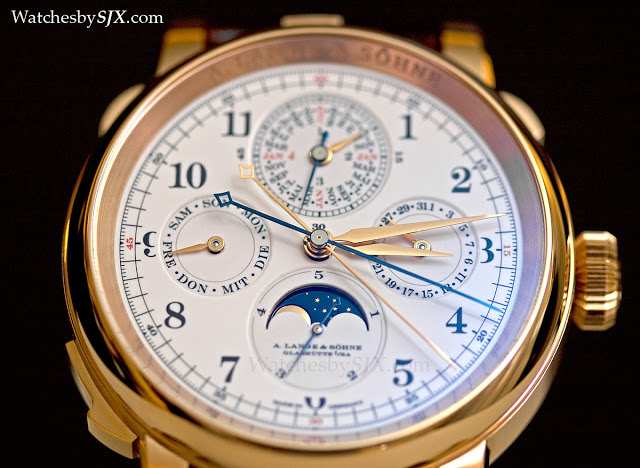Hands-On With The A. Lange & Söhne Grand Complication – The Most Complicated Lange Wristwatch Ever (With Live Photos, Video And Price)
Featuring a grand and petite sonnerie, split-seconds chronograph with lightning seconds, and perpetual calendar, the monumental Grand Complication lives up to its name.
Though much has been written about the Lange Grand Complication launched at SIHH 2013 (where Lange also presented its smaller brother, the 1815 Rattrapante Perpetual Calendar), little of it has been seen aside from stock images. That’s because at SIHH Lange only presented the Grand Complication privately to a handful of people, and no photos were allowed.
But we have managed to get some special, intimate time with the completed and decorated Grand Complication prototype, with none other than Anthony de Haas as our guide, at the recently concluded Watches&Wonders in Hong Kong.
Inspired by the vintage Lange grand complication pocket watch with the serial no. 42500 restored by Lange several years ago, the modern Grand Complication wristwatch is planned as a limited edition of six timepieces, as well as one prototype pictured here.
Named L1902 because the original pocket watch was made in 1902, the movement of the Grand Complication has a grand and petite sonnerie; minute repeater; monopusher, split-seconds chronograph with 1/5 second foudroyante; and perpetual calendar with moon phase. All of that requires three barrels and three gear trains, one for the time and calendar, another for the sonnerie and the last for the lightning seconds. The following video clip shows the grand sonnerie in action at 12:45, with 12 strikes for the hours and three double strikes for the quarters.
876 parts make up the L1902 movement, which is housed inside a massive pink gold case. At 50 mm wide and 20.3 mm high, the Grand Complication is actually a pocket watch with lugs. That leads to the obvious question: why not make it a pocket watch?
According to de Haas, Lange’s Director of Product Development, the point was not to make a pitch perfect replica of the original pocket watch, but rather to adapt it for contemporary use.
| The Grand Complication next to a dimunitive 39 mm Datograph |
That is why although the Grand Complication wristwatch has all the functions of the original, the movement has been significantly improved. Most notably, the grand sonnerie has a safety mechanism, which means the time can be set while the sonnerie is striking; doing so on the vintage pocket watch would result in a vast repair bill.
Another example is the lightning seconds at six o’clock, which blazes round the dial once a second. In the original (and other vintage pocket watches with the same function), running the foudroyante for the equivalent of a month would render it completely worn and usable, says de Haas. Redesigned to be robust, the Grand Complication can now be operated at the owner’s pleasure.
That being said, the Grand Complication still retains many anachronistic movement construction details of nineteenth century watchmaking. The rattrapante mechanism, for example, has no isolator. And the large, gold screws on the balance wheel are actually used to poise the balance. It’s a peculiar combination of new and old watchmaking, something characteristic of Lange.
Because the Grand Complication is Lange’s flagship complication, and also its most expensive with a price of €1.92 million (about US$2.6 million), no expense was spared with the finishing. As de Haas puts it, “We went a bit crazy [with the decoration].”
All the steel parts are black polished, otherwise known as spéculaire. This technique renders the steel surface so perfectly flat that it appears black at certain angles, hence the name. In other Lange chronographs, the Datograph for instance, most steel parts are straight grained on top.
Another notable detail is the cap for the twin column wheels of the chronograph, the first time Lange has included this in a chronograph. These black polished steel caps also feature in the original Grand Complication pocket watch, but they are not merely for show.
De Haas explains that because the column wheel farthest from the balance wheel has two levels, the lower one for the chronograph lever and the other for the lightning seconds, the cap was required to keep the foudroyante lever in position. And the other column wheel, which only has a single level, was capped as well to keep the design consistent.
Though the view from the front is nowhere near as spectacular as that of the movement, the is evident no expense was spared. Made of five pieces fused together (comprising each sub-dial and the main dial plate), the dial is white enamel, thick and glossy, and the hands are either solid gold or blued steel.
In the movement it is most obvious, but in every detail this watch reeks quality. In fact, even though this watch pictured is a prototype, an inordinate amount of effort was clearly lavished on completing it, especially on the movement decoration.
But all that craftsmanship, the thousands of hours of labour, begs the question: why?
Tony de Haas answered that question somewhat in an earlier interview. For me personally, the Grand Complication is a titanic, nearly unwearable timepiece with an absolutely ghastly price tag. And it contributes little to the body of watchmaking knowledge in terms of innovation, since it embodies all the traditions and crafts of watchmaking – as it was practised a hundred years ago.
But it is an exceptional and vastly impressive timepiece. If one thinks about the philosophy of Lange in its modern incarnation, the Grand Complication is actually the zenith of that watchmaking doctrine.
Practically all of the Lange wristwatches considered important and significant, the Datograph and the first Pour le Merite Tourbillon are the most obvious examples, are at heart nineteenth century watchmaking transplanted into a modern wristwatch. The Grand Complication is the grandest expression yet of that idealogy.
– SJX